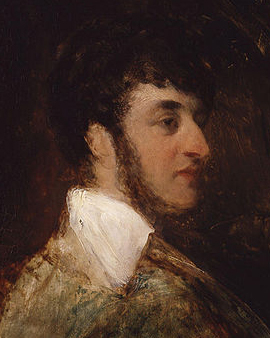The British artist John Frederick Lewis painted impressive colourful paintings with everyday impressions of the Mediterranean and the Far East. He was born in 1804 in the metropolis of London. As the son of a copper engraver and landscape painter, he was able to look over his father's shoulder as a child while he produced artistic paintings. In addition, he trained his talent together with the neighboring boy and later animal painter Edwin Landseer. In many later works, therefore, animals appeared, for example in "The Lioness" (1824), "Twelve Domesticated Animals" (1826), or "Spanish Couple Riding a Mule" (1832).
John Frederick Lewis showed himself to be very fond of travelling from 1827 and visited several European countries while painting with watercolours. From 1832 onwards, his thirst to get to know other cultures led him to Spain, Morocco, Greece and then to Constantinople. By the time he finally settled in Cairo for ten years in 1841, he had become an important painter of Orientalism. He lived in a traditional but distinguished house in the turbulent city, which served as a background landscape in his works several times. He adapted his personal lifestyle to the oriental culture. His friend and satirist William Makepeace Thackeray, who visited him, described him as ponderous, dreamy and a cigarette-smoking villager. After his return from Egypt, Lewis lived in Walton-on-Thames, England, from 1854, where he died in 1876. His enthusiasm for oriental life remained very much alive in him to the end and he transformed many of the drawings he had made in Cairo into colour paintings. One of his most important paintings was exhibited in London and was highly praised by critics. It is "The Hareem" (1850) and was painted by Lewis during his last two years under the sun of Egypt.
×





.jpg)
.jpg)
 - (MeisterDrucke-15488).jpg)
 - (MeisterDrucke-15488).jpg)
 - (MeisterDrucke-193177).jpg)
 - (MeisterDrucke-193177).jpg)
.jpg)
.jpg)
.jpg)
.jpg)
.jpg)
.jpg)
.jpg)
.jpg)
 - (MeisterDrucke-218256).jpg)
 - (MeisterDrucke-218256).jpg)
.jpg)
.jpg)
.jpg)
.jpg)
.jpg)
.jpg)
 from Sketches and - (MeisterDrucke-308142).jpg)
 from Sketches and - (MeisterDrucke-308142).jpg)
 and the Tower - (MeisterDrucke-305154).jpg)
 and the Tower - (MeisterDrucke-305154).jpg)
.jpg)
.jpg)
.jpg)
.jpg)
.jpg)
.jpg)
.jpg)
.jpg)
.jpg)
.jpg)
_-_(MeisterDrucke-382557).jpg)
_-_(MeisterDrucke-382557).jpg)
.jpg)
.jpg)
 from Sketches and Dr - (MeisterDrucke-256923).jpg)
 from Sketches and Dr - (MeisterDrucke-256923).jpg)
.jpg)
.jpg)
.jpg)
.jpg)
.jpg)
.jpg)
.jpg)
.jpg)
_-_(MeisterDrucke-89525).jpg)
_-_(MeisterDrucke-89525).jpg)
.jpg)
.jpg)
.jpg)
.jpg)
_-_(MeisterDrucke-312610).jpg)
_-_(MeisterDrucke-312610).jpg)
.jpg)
.jpg)
.jpg)
.jpg)
_(see_also_22700)_-_(MeisterDrucke-551132).jpg)
_(see_also_22700)_-_(MeisterDrucke-551132).jpg)
_from_Sketches_-_(MeisterDrucke-282231).jpg)
_from_Sketches_-_(MeisterDrucke-282231).jpg)
 from Sketches and Drawings of the Alhambra 1835 - (MeisterDrucke-190340).jpg)
 from Sketches and Drawings of the Alhambra 1835 - (MeisterDrucke-190340).jpg)
.jpg)
.jpg)
.jpg)
.jpg)
.jpg)
.jpg)
.jpg)
.jpg)
.jpg)
.jpg)
 (see also 43799) - (MeisterDrucke-188253).jpg)
 (see also 43799) - (MeisterDrucke-188253).jpg)
.jpg)
.jpg)
.jpg)
.jpg)
.jpg)
.jpg)
.jpg)
.jpg)
.jpg)
.jpg)
.jpg)
.jpg)
.jpg)
.jpg)
.jpg)
.jpg)
 Bursa Turkey - (MeisterDrucke-15658).jpg)
 Bursa Turkey - (MeisterDrucke-15658).jpg)
_-_(MeisterDrucke-546505).jpg)
_-_(MeisterDrucke-546505).jpg)
.jpg)
.jpg)
.jpg)
.jpg)
.jpg)
.jpg)
.jpg)
.jpg)
.jpg)
.jpg)
.jpg)
.jpg)
.jpg)
.jpg)
.jpg)
.jpg)
.jpg)
.jpg)
.jpg)
.jpg)
.jpg)
.jpg)
.jpg)
.jpg)
_-_(MeisterDrucke-896694).jpg)
_-_(MeisterDrucke-896694).jpg)
_-_(MeisterDrucke-1433477).jpg)
_-_(MeisterDrucke-1433477).jpg)
.jpg)
.jpg)
.jpg)
.jpg)
.jpg)
.jpg)
.jpg)
.jpg)
.jpg)
.jpg)
.jpg)
.jpg)
.jpg)
.jpg)
.jpg)
.jpg)
.jpg)
.jpg)
_-_(MeisterDrucke-905381).jpg)
_-_(MeisterDrucke-905381).jpg)
_from_Sketches_and_Drawings_of_the_A_-_(MeisterDrucke-317292).jpg)
_from_Sketches_and_Drawings_of_the_A_-_(MeisterDrucke-317292).jpg)
.jpg)
.jpg)
.jpg)
.jpg)
.jpg)
.jpg)
.jpg)
.jpg)
.jpg)
.jpg)
 - (MeisterDrucke-110438).jpg)
 - (MeisterDrucke-110438).jpg)
 and the Palace - (MeisterDrucke-249624).jpg)
 and the Palace - (MeisterDrucke-249624).jpg)
.jpg)
.jpg)
.jpg)
.jpg)
.jpg)
.jpg)
.jpg)
.jpg)
.jpg)
.jpg)
.jpg)
.jpg)
 from Sketches and Drawings of the Alhambra engraved by William Gauci (fl1825-54) 1835 - (MeisterDrucke-192555).jpg)
 from Sketches and Drawings of the Alhambra engraved by William Gauci (fl1825-54) 1835 - (MeisterDrucke-192555).jpg)
.jpg)
.jpg)
.jpg)
.jpg)
.jpg)
.jpg)
.jpg)
.jpg)
.jpg)
.jpg)
.jpg)
.jpg)
.jpg)
.jpg)
.jpg)
.jpg)
.jpg)
.jpg)
.jpg)
.jpg)
.jpg)
.jpg)






